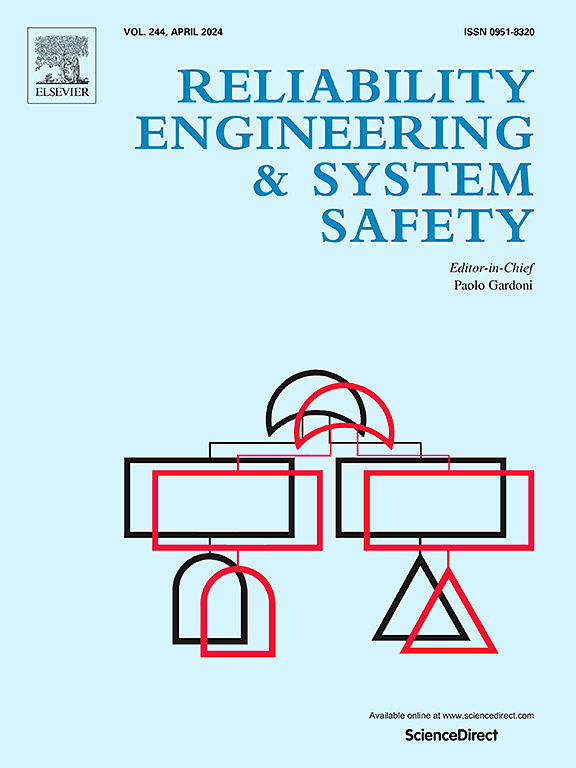A novel d-flow network decomposition algorithm for fast search and efficient storage of all d-MPs
IF 9.4
1区 工程技术
Q1 ENGINEERING, INDUSTRIAL
引用次数: 0
Abstract
The d-MPs algorithm is one of the main algorithms for calculating the reliability of multi-state flow networks (MFNs). However, two issues remain unresolved in existing algorithms searching for d-MPs: redundant calculations during network decomposition and efficient storage of all d-MPs. A novel d-flow network decomposition algorithm is proposed to resolve the abovementioned issues. During the process of network decomposition with the demand d, the storage and identification of isomorphic subgraphs are utilized to avoid redundant decomposition of the subgraphs. Additionally, all d-MPs are stored in a directed graph, and finally, the depth-first search (DFS) algorithm is employed to search for all d-MPs. Furthermore, the proposed algorithm's time and space complexity is analyzed. Experimental results on the selected networks with different scenarios show that the efficiency of the proposed algorithm is significantly higher than the previous efficient methods in most cases. In Example 2, when d = 13, the proposed algorithm outperforms the previous fastest algorithm by 3.4 times. Additionally, Example 3 demonstrates that over 5.4 × 10⁶ valid d-MPs can be stored in a directed graph with only 819 vertices and 1572 edges, indicating the proposed method substantially reduces memory usage.
- 1.The network is connected and free of self-loops;
- 2.The capacity of each edge is a non-negative integer following a given probability distribution;
- 3.The capacities of different edges are statistically independent.
- 4.The vertex is perfectly reliable.
- 5.The flow conservation law is obeyed.
一种新的d流网络分解算法,用于快速搜索和有效存储所有d-MPs
d-MPs算法是计算多状态流网络(MFNs)可靠性的主要算法之一。然而,在现有的d-MPs搜索算法中,有两个问题尚未解决:网络分解过程中的冗余计算和所有d-MPs的有效存储。针对上述问题,提出了一种新的d流网络分解算法。在基于需求d的网络分解过程中,利用同构子图的存储和识别来避免子图的冗余分解。此外,将所有d-MPs存储在有向图中,最后使用深度优先搜索(DFS)算法搜索所有d-MPs。进一步分析了该算法的时间和空间复杂度。在选择的不同场景的网络上进行的实验结果表明,在大多数情况下,本文算法的效率明显高于之前的高效方法。在例2中,当d = 13时,本文算法的性能是之前最快算法的3.4倍。此外,例3表明,在一个只有819个顶点和1572条边的有向图中,可以存储超过5.4 × 10⁶有效的d-MPs,这表明所提出的方法大大减少了内存使用。1 .网络连通,无自环路;2 .每条边的容量是一个非负整数,服从给定的概率分布;不同边的容量在统计上是独立的。顶点是完全可靠的。遵循流动守恒定律。
本文章由计算机程序翻译,如有差异,请以英文原文为准。
求助全文
约1分钟内获得全文
求助全文
来源期刊

Reliability Engineering & System Safety
管理科学-工程:工业
CiteScore
15.20
自引率
39.50%
发文量
621
审稿时长
67 days
期刊介绍:
Elsevier publishes Reliability Engineering & System Safety in association with the European Safety and Reliability Association and the Safety Engineering and Risk Analysis Division. The international journal is devoted to developing and applying methods to enhance the safety and reliability of complex technological systems, like nuclear power plants, chemical plants, hazardous waste facilities, space systems, offshore and maritime systems, transportation systems, constructed infrastructure, and manufacturing plants. The journal normally publishes only articles that involve the analysis of substantive problems related to the reliability of complex systems or present techniques and/or theoretical results that have a discernable relationship to the solution of such problems. An important aim is to balance academic material and practical applications.
 求助内容:
求助内容: 应助结果提醒方式:
应助结果提醒方式:


